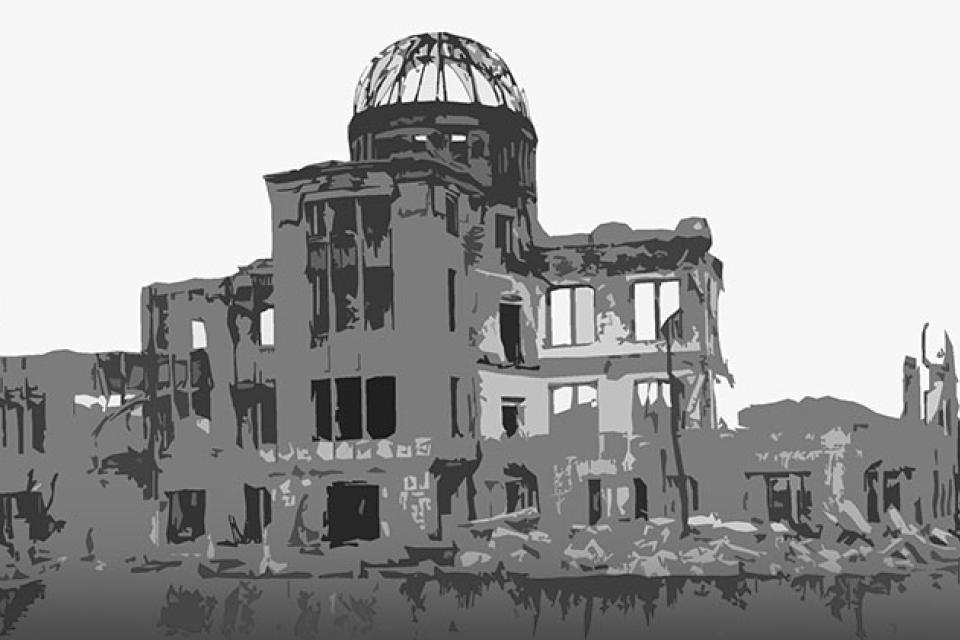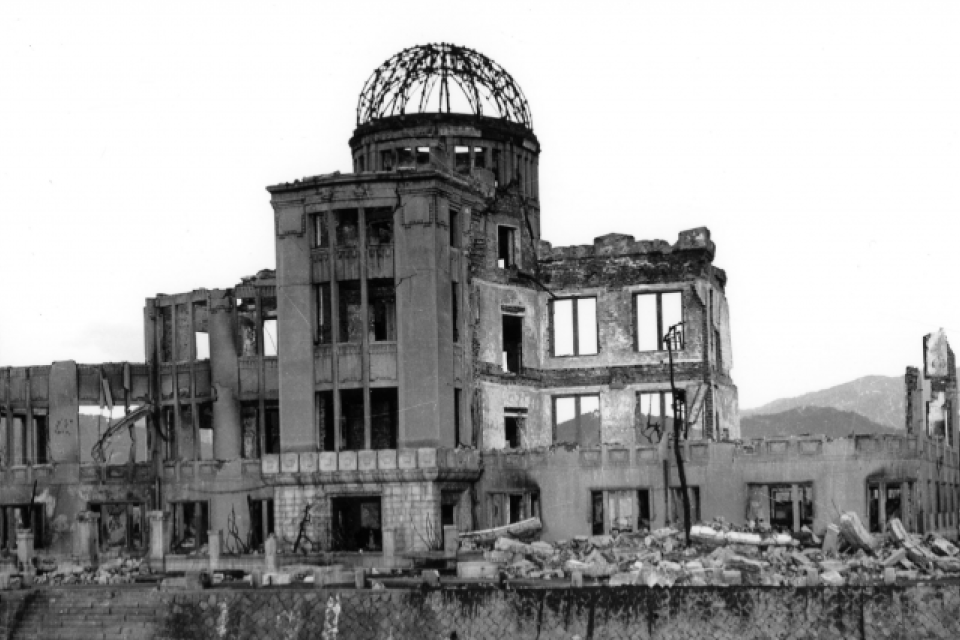FOR IMMEDIATE RELEASE - October 10, 2019
PRESS CONTACTS:
Masako Miki - mmiki@janm.org - 213-830-5636

“UNDER A MUSHROOM CLOUD: HIROSHIMA, NAGASAKI, AND THE ATOMIC BOMB” TRAVELING EXHIBITION TO OPEN AT JANM FROM NOVEMBER 9, 2019 TO JUNE 7, 2020
Los Angeles—Under a Mushroom Cloud: Hiroshima, Nagasaki, and the Atomic Bomb, a traveling exhibition organized by the two affected Japanese cities, will be installed at Japanese American National Museum in Little Tokyo, beginning on November 9, 2019 and running until June 7, 2020.
The traveling exhibition, which helps to mark the upcoming 75th Anniversary next year of the atomic bombings, was conceived and prepared by the only two cities in the world ever to be subjected to nuclear bombs in 1945: Hiroshima on August 6, and Nagasaki on August 9. Over 200,000 people died immediately or by the end of the year and both cities were structurally ruined. The aftereffects of the radiation on the survivors have continued until this day, yet both cities rebuilt rather than abandon their historic sites.
Under a Mushroom Cloud features the damaged possessions left by the victims. Hiroshima and Nagasaki collected and preserved these artifacts, including clothing and other personal items. The exhibition is composed of photo panels and text panels that detail the histories of the cities, the development of the two bombs, their detonations, and the immediate aftermath for the survivors, known in Japan as hibakusha, of both cities. Besides the artifacts, the exhibition will feature origami cranes folded by President Obama and Sadako Sasaki.
JANM will supplement the exhibition with panels focusing on the number of Japanese Americans who were caught in the bombings, especially in Hiroshima. Before World War II, it was common for immigrant Issei parents to send their American-born Nisei children to Japan for education. By some estimates, approximately 15,000 Japanese Americans were living in Japan in 1945. Because large number of Japanese immigrants came from Hiroshima, many children were sent there to live with relatives and endured the explosion. Those that survived and were able to return to the United States faced on-going health issues which were unfamiliar to the American medical community.
In addition, JANM will include different perspectives on the atomic bombings and their aftermath developed by six Japanese and Japanese American artists: painter Yuri Mason; photographers Darrell Miho and Patrick Nagatani; interdisciplinary artist Alan Nakagawa; poet and book collector Brandon Shimoda; and, visual artist and filmmaker Shinpei Takeda. Their various works focus on the plight of the victims and survivors.
“The Japanese American National Museum is honored to be the venue of this historically significant exhibition,” stated Ann Burroughs, President and CEO of JANM. “Under a Mushroom Cloud shares a chapter of history that all of humanity should know and understand. It is to the credit of the cities of Hiroshima and Nagasaki that they created this exhibition with the hope that by sharing these stories, no one would want to employ nuclear weapons ever again. JANM decided to add to this exhibition, highlighting the Japanese American historic connection to these events while displaying artwork that touches upon the emotional magnitude of this story.”
Under a Mushroom Cloud was created through a partnership between the cities of Hiroshima and Nagasaki. The principal sponsors for the exhibition are Mazda North American Operations, and Otafuku Sauce Co., Ltd., companies that have historic connections to Hiroshima. It is also supported by the Japan Foundation, Los Angeles; the Hiroshima Peace Grant from the Hiroshima Peace Creation Fund; Wakunaga of America Co., Ltd.; and the Philip and Masako Togo Kasloff Foundation.
THE EXHIBITION
The traveling exhibition consists of 30 panels and 20 artifacts developed and collected by the cities of Hiroshima and Nagasaki. These artifacts will be on display until March 1, 2020, before they are returned to Japan.
The panels provide detailed profiles on a number of subjects. Besides a brief history of both cities, the exhibition touches on the development of the atomic bomb by the United States, the decision to use it against Japan and the reasons to target Hiroshima and Nagasaki. It also explains the difference between the uranium-235 (“Little Boy”) bomb dropped on Hiroshima and the plutonium-239 (“Fat Man”) bomb exploded over Nagasaki.
Through photographs, the exhibition depicts the cities before the explosions and immediately afterward. The human costs are shown through photos and artwork, including the long-term effects of radiation. The story concludes with Hiroshima and Nagasaki rebuilding and recovering and the determination of the hibakusha to lobby against of the use of nuclear weapons ever again.
JANM will introduce panels that focus on the Japanese American survivors of the atomic bombings and their physical and emotional issues after their return to the United States.
ARTIFACTS
Among the traveling artifacts:
- A rosary belonging to a group of parishioners who were attending mass at the Urakami Cathedral in Nagasaki when the explosion occurred. Nagasaki has one of the oldest Christian communities in Japan;
- A blouse belonging to Mutsuko Shimogochi, 15, who was a student at Shintoku Girls High School in Hiroshima. She was walking near Shirakami Shrine when the bomb exploded and was badly burned. She managed to make it home, but passed away two days later.
- An origami crane folded by President Barack Obama in 2016 while visiting the Hiroshima Peace Memorial Museum. He was the first sitting President to visit the city of Hiroshima and the Peace Memorial.
- An origami crane folded by Sadako Sasaki, a survivor of the Hiroshima bomb, who suffered from radiation sickness after the war. Sadako became famous for having folded 1,000 cranes during her illness.
Artwork by the Japanese and Japanese American artists will include Particle Painting Untitled #2 (acrylic on canvas) by Yuri Mason; photos of surviving hibakusha living in Japan, America, Canada, and South Korea by Darrell Miho; Trinity Site, Jornada Del Muerto, New Mexico (chromogenic print) by Patrick Nagatani; a sound installation by Alan Nakagawa; a collection of 160 books collected by Brandon Shimoda; and Alpha Decay (ink on paper) by Shinpei Takeda.
PUBLIC PROGRAMS
Passing the Legacy: Hiroshima and Nagasaki
Saturday, November 9 • 2 p.m.–4 p.m.
In conjunction with the opening of Under a Mushroom Cloud: Hiroshima, Nagasaki and the Atomic Bomb, there will be special presentations from the exhibition’s curators, the director of Hiroshima Peace Memorial Museum, and atomic bomb survivors.
Under a Mushroom Cloud Film Festival
Saturday, January 18 • 11 a.m.–6:30 p.m.
In conjunction with Under a Mushroom Cloud, JANM is hosting a day-long Under a Mushroom Cloud Film Festival. JANM will screen three world acclaimed films related to the atomic bombs. These films tell the story of people who were under the two mushroom clouds. JANM encourages the public to see the films and share these stories of resilience, love, and hopes for peace. This festival is co-presented with the Japan Foundation, Los Angeles.
- The Face of Jizo (99 min, 2004, Director: Kazuo Kuroki)
- In This Corner of the World (129 min, 2016, Director: Sunao Katabuchi)
- Paper Lanterns (60 min, 2016, Director: Barry Frechette)
# # #
NOW ON VIEW AT JANM:
At First Light: The Dawning of Asian Pacific America
Through October 20, 2019
At First Light: The Dawning of Asian Pacific America is a multi-media exhibition that explores and celebrates the emergence of a politically defined Asian Pacific American consciousness and identity. A co-production of Visual Communications (VC) and the Japanese American National Museum, At First Light chronicles the transformation of the un-American categorization of “Oriental” to the political identity of “Asian Pacific American” that rejected racist stereotypes, stood up for human rights, recovered lost histories, and created new cultural expressions. The exhibition draws from the collections of VC, the first Asian Pacific American media organization in the country, which formed in Los Angeles in 1970 to capture and cultivate the newfound unity that was Asian Pacific America. The resiliency and resistance embodied in At First Light serve as a reminder—as well as a call to action—of what can be accomplished when people unite as a community with commitment.
Fighting for Democracy: Who is the “We” in “We, the People”?
Through January 5, 2020
We, the people, shape democracy;
I, too, can shape democracy;
Those who have struggled for freedom and equality have extended democracy’s reach for all.
Fighting for Democracy: Who is the “We” in “We, the People”? is an experimental exhibition based on these fundamental principles. It features seven real people and traces their stories throughout the prewar, World War II, and post-war periods as examples of the millions of Americans whose lives were affected by the war and how each sought equal rights for their families and communities.
Common Ground: The Heart of Community
Ongoing
Incorporating hundreds of objects, documents, and photographs collected by JANM, this exhibition chronicles 130 years of Japanese American history, from the early days of the Issei pioneers through the World War II incarceration to the present. In commemoration of the 30th anniversary of the Civil Liberties Act of 1988, the final section of Common Ground has been reimagined to further emphasize the redress movement, the landmark passage of the Act, and its relevance today.
About the Japanese American National Museum (JANM), a Smithsonian Affiliate
Established in 1985, the Japanese American National Museum promotes understanding and appreciation of America’s ethnic and cultural diversity by sharing the Japanese American experience. Located in the historic Little Tokyo district of downtown Los Angeles, JANM is a hybrid institution that straddles traditional museum categories and strives to provide a voice for Japanese Americans as well as a forum that enables all people to explore their own heritage and culture. Since opening to the public, JANM has presented nearly 100 exhibitions onsite and traveled 20 of its exhibitions to locations around the world, including the Smithsonian Institution and the Ellis Island Museum in the United States, and several leading cultural museums in Japan and South America.
JANM is located at 100 N. Central Ave., Los Angeles. Museum hours are Tuesday, Wednesday, Friday, Saturday, and Sunday from 11 a.m. to 5 p.m. and Thursday from noon to 8 p.m. General admission is $12 adults, $6 students and seniors, free for members and children under age five. Effective August 16, admission will be $16 for adults, and $7 for students and seniors. Admission is free to everyone on Thursdays from 5 p.m. to 8 p.m. and every third Thursday of the month from noon to 8 p.m. General admission prices and free admission times may not apply to specially ticketed exhibitions. Closed Monday, 4th of July, Thanksgiving, Christmas, and New Year’s Day. For more information visit janm.org or call 213.625.0414.
PRESS PHOTO GALLERY
Password Access Only. Contact mediarelations@janm.org for access.
Under a Mushroom Cloud: Hiroshima, Nagasaki, and the Atomic Bomb
View Gallery

